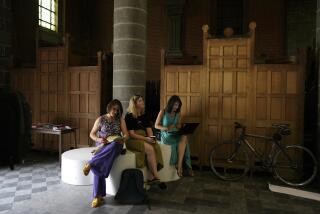Belgium’s the Place for Fine Handmade Lace
- Share via
BRUGES, Belgium — You could say that Belgian history is woven in lace.
In the 16th Century, lace was included in the notarized property lists of aristocrats. It was considered so valuable that those found guilty of smuggling it or stealing patterns were punished.
By the 18th Century, other patterns and techniques--such as rosaline and duchesse--had evolved. In fact, over the centuries, thousands of lace maker’s variations have been invented, some using as many as 1,200 threads woven into complex patterns.
Creating patterns is the hardest part of lace making, sometimes requiring a genius for strategy. To see lace being made is to appreciate its complexity.
Throughout history, lace makers have not signed their work. But the Belgian lace industry has strict standards for ensuring authenticity. Lace of recent vintage, still made at home and then sold to shops, is certified as handmade. Size and complexity determine value. Antique lace is recognizable by its fine thread and intricacy.
Belgian lace is all handmade--an essential distinction--with bobbin and other techniques.
A contemporary lace-making renaissance in Belgium is concentrated in Bruges at the Belgian Lace Center’s workshop (Peperstraat 3), where students at all levels of accomplishment and from around the world are instructed in traditional patterns and techniques.
Government subsidy allows the center to sell equipment and supplies at just above cost, and instruction is inexpensive (about $40 buys a year’s membership in the workshop; two-week intensive courses during the summer cost about $70 per person for groups of 15).
Tourists may observe the workshop and visit the center’s museum for about $1. The center also publishes and sells books about lace making.
Lace shops abound in Bruges. Apostelientje Lace Shop (Balstraat 11) offers a fine selection of antique and contemporary lace. There are doilies ($25 to $30, depending upon size) and framed 12-inch decorative pieces, including a charming baby buggy ($25) and lace maker ($80).
A 5- by 3-foot oval tablecloth (made during the 1920s) sells for about $2,200, while 1850s decorative pieces, including a bouquet of flowers mounted on blue velvet and framed, sell for about $325. Vintage lace collars that drape over the shoulders cost about $300.
The Little Lace Shop (Markt 11) is a good source for investment lace, including monumental lace tablecloths and napkin sets that sell for thousands of dollars. However, the shop also sells doilies, collars, gloves and decorative pieces for prices comparable to those at Apostelientje.
Bobbin Lace Palace (Breidelstraat 20, adjacent to Markt) is a highly reputable shop, but some of its handmade lace is mounted on machine-made net, and some machine-made ribbon is used. Ask about this before buying lace-trimmed linen tablecloths (two by three yards) for $250 to $500, or similar clothes in cotton blends for $125 to $190. The price usually includes eight to 12 matching napkins. Runners cost $120 to $250. The decorative lace cats, candles, birds, hearts, steamboats, balloons and other items in 8- or 15-inch oval frames for $16 to $60 are popular souvenirs.
Souvenir lace is even less expensive at Firma Pickery (Vismarkt 13, near the old Fish Market), where dozens of doilies and runners cost from $1 to $70.
Brussels, too, has dozens of lace shops. Manufacture Belge de Dentelles (Galerie de la Reine 6-8) is a must. The shop, run by the Mallit family since 1810, has an exceptional selection of recent objects, including parasols, christening robes and fans, as well as more utilitarian items and a collection of antique lace.
The shop buys from about 200 lace makers, who provide reasonably priced tablecloths and lovely handkerchiefs ($6 to $60).
At Grand Place 23, the Rubbrecht Lace Shop has cabinets full of antique lace, including some lovely mantillas. A rectangular lace decorative piece, measuring about 3 by 3 1/2 feet and dating from the 1850s, is rose point mounted on handmade needlepoint net that sells for about $2,000.
Another rectangle in duchesse point, dating from the 1900s, sells for about $350. There are also antique handkerchiefs for about $80 to $500. These are investment pieces, but the shop also has a broad range of less expensive contemporary lace that makes great gifts or souvenirs.
Brussels, too, has a lace workshop, but its emphasis is on contemporary style and construction and only experienced lace makers are allowed to participate. Located at the Museum of Costume and Lace (Rue de la Violette 6), the 20th Century Lace Workshop is run by master lace maker Colette van Steyvoort, a pioneer in contemporary lace making.
Van Steyvoort’s own beautiful and innovative pieces, shown at the museum, incorporate colored threads and various materials, including feathers, in standing and hanging objects. She is constantly researching ways to give new dimension to lace making. Prices for her pieces are from $2,000 to $4,500, but she only sells privately and can be reached at 011-32-2/375-2575 for appointments.
Prices quoted in this article reflect currency exchange rates at the time of writing.
More to Read
Sign up for The Wild
We’ll help you find the best places to hike, bike and run, as well as the perfect silent spots for meditation and yoga.
You may occasionally receive promotional content from the Los Angeles Times.






